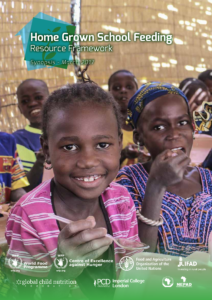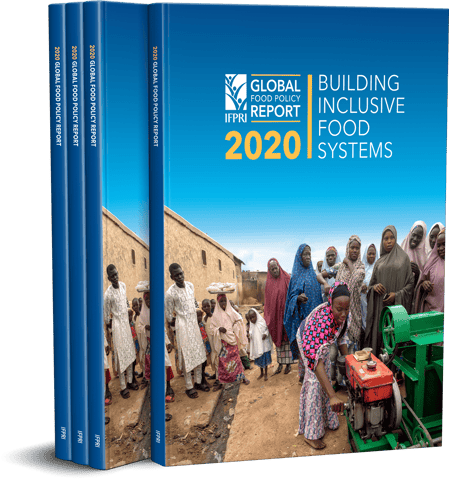7 April 2020. The rapid spread of COVID-19 and efforts to contain it are generating growing concerns that food insecurity, malnutrition, and poverty may escalate, particularly among marginalized people in the developing world.
To build more resilient, climate-smart, and healthy food systems that help people withstand these types of shocks policymakers must prioritize making them inclusive, according to the 2020 Global Food Policy Report, released by the International Food Policy Research Institute (IFPRI).
IFPRI. 2020. Global Food Policy Report: Building Inclusive Food Systems. Washington, DC: International Food Policy Research Institute. April 2020. 110 pages.
Expanding and more profitable food markets can encourage the concentration of food value chains in large commercial farms and large-scale processors and distributors (supermarkets), possibly excluding smallholders. To benefit from market opportunities, small-scale producers will have to adjust to ongoing market changes and increasingly stringent food quality and safety requirements in downstream food value-chain segments. (page 17)
National food systems in low- and middle-income countries (LMICs) are transforming rapidly from traditional to modern. This is part of a larger story of rural transformation, urbanization, and development that can offer new opportunities for inclusion of poor and marginalized people. In addition to creating employment and income-generating opportunities, transformation can also support improvements in nutrition that are associated with long-term impacts on health, cognitive capacity, educational attainment, income, and development. (page 55)
Policymakers need to know what policies, investments, and actions they can take to ensure food systems transform in a healthy, sustainable, and equitable way. (page 55)
In Vietnam export value chains benefit from substantial private sector capacity, knowledge, and protocols for producing safe food, and people working in exports have substantial training and earn a notable premium. The government is committed to establishing a single standard for both exports and domestic food to replace the lower standards that prevail in wet markets. But the implementation of food safety management in the large system of informal markets is weak and marked by poor compliance in production, processing, and marketing. (page 63)
Growth in spending on agricultural research has been slower than growth in agricultural output in
SSA. However, if the region did meet this ambitious goal, agriculture sector productivity would be 62 percent higher by 2050 than it is today, with major gains for well-being. (page 90)
The Home-Grown School Feeding Resource Framework
supports governments through the process of policy formulation, implementation and evaluation of school meals programmes. It also brings together the technical expertise of different stakeholders in a programmatic and coherent way to be easily accessed by countries requesting technical assistance.
Ghana’s Home Grown School Feeding (HGSF) program provides school meals through caterers who are directly contracted by the government. Each caterer is responsible for buying food from local farmers and preparing and distributing meals to schools. In a complementary pilot program, caterers have been asked to source food from smallholders and are trained to use local, district-specific menus that meet both dietary preferences and nutritional requirements and recipes that use fresh seasonal foods that can be purchased from producers in the targeted communities.
In Malawi programs like the existing school meals program could be modified to purchase leafy green vegetables, increasing demand in village markets where these foods are highly available but buyers are few. (page 65)
To build more resilient, climate-smart, and healthy food systems that help people withstand these types of shocks policymakers must prioritize making them inclusive, according to the 2020 Global Food Policy Report, released by the International Food Policy Research Institute (IFPRI).
Full Report (110 pages) or the synopsis (12 pages)
Taking a food systems approach allows countries to consider a wide range of current challenges, from food security to climate change to diet transition, and opportunities, such as digital technology and building youth skills and entrepreneurial capacity, that are most relevant to their particular contexts. For LMICs, a food systems approach provides broad benefits in terms of designing effective, inclusive policies that can contribute to better nutrition outcomes. At present, a food systems approach is not proactively applied in most countries. (page 65)
National food system transformation strategies must be aggressively augmented with coordinated efforts to support groups left behind. (page 65)Food systems are critical to every aspect of people’s well-being, from what they eat to how they earn their livelihoods to their options for the future. IFPRI’s flagship report highlights the critical role that inclusive food systems can play in improving nutrition, creating employment and income-generating opportunities, and increasing empowerment of disadvantaged groups.
- Johan Swinnen, Director General, IFPRI
- John McDermott, Director, CGIAR Research Program on Agriculture for Nutrition and Health (A4NH)
- Rob Vos, Director, Markets, Trade and Institutions Division, IFPRI
- Laura Zseleczky, Program Manager, IFPRI
- Moderator: Rajul Pandya-Lorch, Director, Communications and Public Affairs, IFPRI
Across the developing world national food systems are already transforming rapidly, creating challenges and opportunities to make them more inclusive to all these groups. Case studies of these transformations in Bangladesh, Ethiopia, Nigeria, and Viet Nam provide useful examples of the drivers and components of change, as well as the promising entry points for actions that can increase inclusion.“Food systems provide opportunities to improve food and nutrition security, generate income, and drive inclusive economic growth, but even in prosperous times too many people are excluded from fully participating in them and securing these benefits. In times of crisis like today, inclusion is an even greater imperative for protecting the most vulnerable. The spread of COVID-19 has highlighted how vulnerable we all can be to global shocks.Greater inclusivity in food systems is not a panacea for this or any other crisis, but it is a critical part of strengthening our resilience. Times of crises also offer opportunities for change and it is essential that we act now so that everyone, especially the most vulnerable, can recover from the COVID-19 shock and be prepared to withstand future shocks.” Johan Swinnen, director general of IFPRI.
Extracts of the report:“Approaches to food system transformation must be country specific, as each country’s food system is unique” John McDermott, director of the CGIAR Research Program on Agriculture for Nutrition and Health.
IFPRI. 2020. Global Food Policy Report: Building Inclusive Food Systems. Washington, DC: International Food Policy Research Institute. April 2020. 110 pages.
IFPRI researchers and other experts contributed chapters on the challenges faced by smallholders, youth, women, and conflict-affected people, and the opportunities offered by expanding agrifood value chains and national food system transformations. Critical questions addressed in this report include:
- How can inclusive food systems help break the intergenerational cycle of poverty and malnutrition?
- What can be done to strengthen the midstream of food value chains to improve rural access to jobs, markets, and services?
- Will Africa’s food systems generate sufficient jobs for the growing youth population?
- How can women be empowered within food system processes, from household decisions to policymaking?
- Can refugees and other conflict-affected people be integrated into food systems to help them rebuild their lives?
- How can national food system transformations contribute to greater dietary diversity, food safety, and food quality for all?
In Africa south of the Sahara and South Asia (excluding India), smallholdings comprise 70 to 75 percent of farm units, but they generate just 35 to 40 percent of the primary production value of the domestic food sector—substantial, but far less than often claimed. (...) Their more inclusive participation in food-sector growth therefore has significant potential to reduce poverty and improve livelihoods.(page 15-16)
National food systems in low- and middle-income countries (LMICs) are transforming rapidly from traditional to modern. This is part of a larger story of rural transformation, urbanization, and development that can offer new opportunities for inclusion of poor and marginalized people. In addition to creating employment and income-generating opportunities, transformation can also support improvements in nutrition that are associated with long-term impacts on health, cognitive capacity, educational attainment, income, and development. (page 55)
Policymakers need to know what policies, investments, and actions they can take to ensure food systems transform in a healthy, sustainable, and equitable way. (page 55)
Few countries have developed specific plans for food system transformation or engaged the coalition of public and private organizations necessary to implement them. Country-specific approaches are needed because each country’s food system is unique, reflecting national natural resources, market access, and sociocultural traditions as well as the country’s stage of economic transformation. (page 56)
In Ethiopia, a technical working group, composed of representatives from government ministries, NGOs, academia, and civic organizations, is using a consultative process to develop national guidelines based on scientific evidence and local conditions and preferences. These guidelines can be used by consumers to inform food choices and by policymakers for formulating policies and strategies. (page 58)
In Ethiopia, a technical working group, composed of representatives from government ministries, NGOs, academia, and civic organizations, is using a consultative process to develop national guidelines based on scientific evidence and local conditions and preferences. These guidelines can be used by consumers to inform food choices and by policymakers for formulating policies and strategies. (page 58)
In Vietnam export value chains benefit from substantial private sector capacity, knowledge, and protocols for producing safe food, and people working in exports have substantial training and earn a notable premium. The government is committed to establishing a single standard for both exports and domestic food to replace the lower standards that prevail in wet markets. But the implementation of food safety management in the large system of informal markets is weak and marked by poor compliance in production, processing, and marketing. (page 63)
Growth in spending on agricultural research has been slower than growth in agricultural output in
SSA. However, if the region did meet this ambitious goal, agriculture sector productivity would be 62 percent higher by 2050 than it is today, with major gains for well-being. (page 90)
Related:
This documentary follows communities in Kenya and Mali who are benefiting from new government led school feeding programmes that are providing nutritious school meals procured from local smallholder farmers.
This documentary follows communities in Kenya and Mali who are benefiting from new government led school feeding programmes that are providing nutritious school meals procured from local smallholder farmers.
 |
The Home-Grown School Feeding Resource Framework
supports governments through the process of policy formulation, implementation and evaluation of school meals programmes. It also brings together the technical expertise of different stakeholders in a programmatic and coherent way to be easily accessed by countries requesting technical assistance.
Ghana’s Home Grown School Feeding (HGSF) program provides school meals through caterers who are directly contracted by the government. Each caterer is responsible for buying food from local farmers and preparing and distributing meals to schools. In a complementary pilot program, caterers have been asked to source food from smallholders and are trained to use local, district-specific menus that meet both dietary preferences and nutritional requirements and recipes that use fresh seasonal foods that can be purchased from producers in the targeted communities.
In Malawi programs like the existing school meals program could be modified to purchase leafy green vegetables, increasing demand in village markets where these foods are highly available but buyers are few. (page 65)



No comments:
Post a Comment